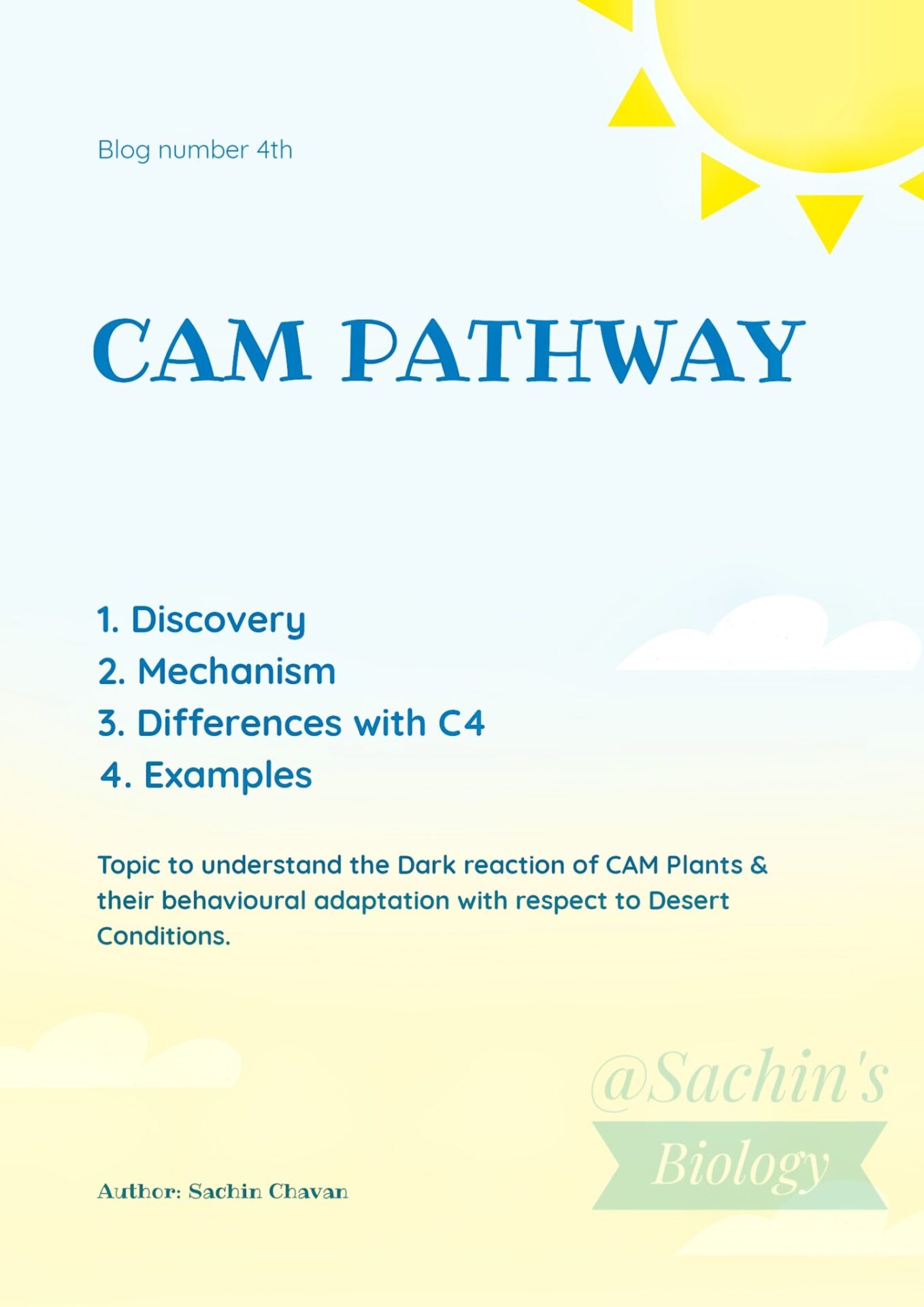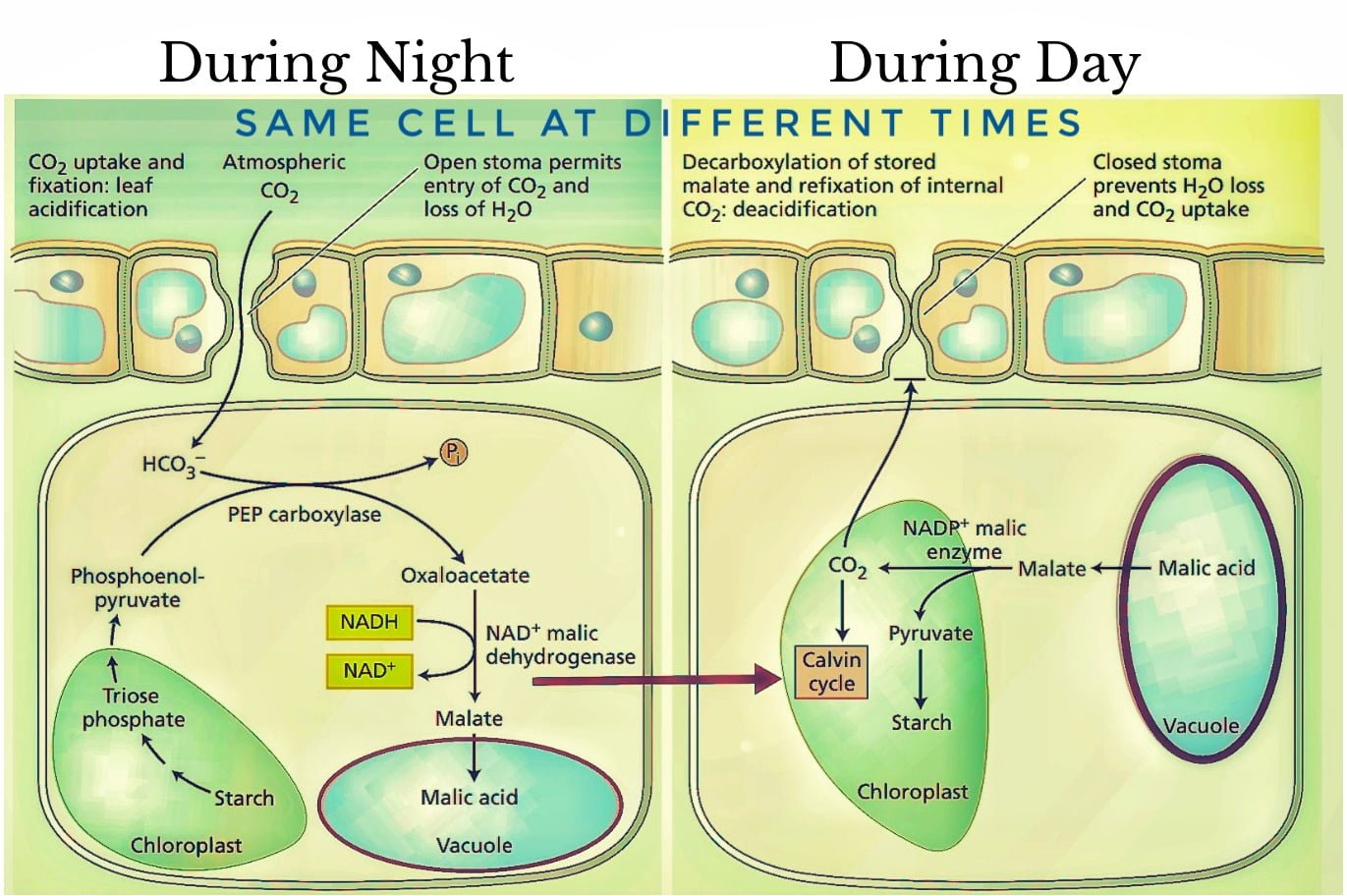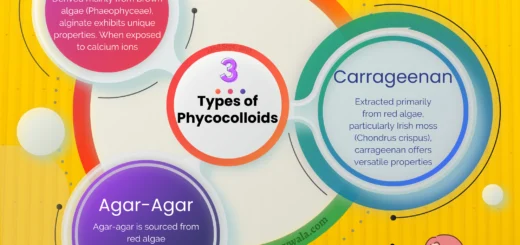Crassulacean Acid Metabolism: The Complete mechanism

Crassulacean Acid Metabolism | what is crassulacean acid metabolism?
Ramson and Thomas in the year of 1940 coined the term Crassulacean Acid Metabolism Pathway (CAM Pathway). It was 1st discovered in Crassulaceae family members of Angiosperms, hence called as crassulacean acid metabolism. The first observation about CAM where made by de Saussure in 1804 in his book Rechercges Chimiques Sur La Vegetation.
Despite the name CAM the pathway does not confine to only the Crassulaceae family members there are other Angiospermic plant families found in the desert which also show Crassulacean Acid Metabolism Pathway.
CAM pathway occurs in xerophytic plants like Aloe vera, Bryophyllum, Opuntia Sedum, Kalanchoe etc.
CAM plants don’t show kranz anatomy like C4 plants but show slight similarities with the C4 mechanism.
The mechanism of CAM pathway helps plants to increase water use efficiency. Let’s see this by comparing CAM plants with C3 and C4 plants:

From the above comparison, it would be clear that CAM plants (CAM pathway) are way better competitors than C3 and C4 plants when it comes to water use efficiency and hence in xerophytic conditions CAM plants have a competitive advantage over C3 and C4 plants.
[The distinct difference between CAM and C4 pathway has given at the end of this article.]
This high water efficiency by CAM plants is the result of opening their stomata during low-temperature periods at night time and closing them in high-temperature periods during hot and dry day time.
Mechanism of crassulacean acid metabolism pathway:
The mechanism of CAM plants is very much similar to the C4 cycle mechanism formation of C4 acid in the C4 plant takes place in a mesophyll cells and is spatially separated from the carboxylation reaction of C4 acid. While Re-fixation of CO2 released from C4 acid is done in bundle sheath cells by the C3 cycle (Calvin Cycle).
Carboxylation:
On the other hand, CAM plants show both temporal and spatial separation of C4 acid during the dark (night) CO2 is captured by PEP carboxylase in the cytosol by incorporating CO2 into PhosphoEnolPyruvate PEP (3C) and producing oxaloacetic acid OAA (4C). This OAA is further reduced into Malate (4C) and transferred to store in the large vacuole. [Note: large vacuoles are the typical character of leaf cells of CAM plants, but they us not compulsory.]
Acidification:
The accumulation of a considerable amount of malic acid similar to the amount of CO2 assimilated at night is recognised as acidification of the leaf. This phenomenon is given by Bonner & Bonner in 1948 and called Nocturnal Acidification of the leaf.
Deacidification:
During light (day) the malic acid stored in the vacuole is transported to the chloroplast. Hence leaf cells get deacidified as the reserves of vacuolar malic acid are consumed. Hence the process is known as the deacidification of leaf cells.
Decarboxylation:
Drincoovich et.al. in 2001 sound that maleic acid transferred in chloroplast undergoes decarboxylation and this is usually achieved by NADP – Malic enzyme and produces CO2 and pyruvate.
The released CO2 is transferred to C3 Cycle (Calvin Cycle) to continue the process of photosynthesis which is the ultimate aim of the CAM pathway. The remaining pyruvate is again converted back into sucrose and starch, which are the source of the original carbon acceptor (PEP).

Special case :
Plants with crassulacean acid metabolism pathway show long-term regulation and are able to adjust their behaviour of CO2 uptake to environmental conditions. The plants which alter their behaviour with environmental conditions are called facultative CAM plants.
Example:
Mesembryanthemum crystallinum shows the C3 mechanism under unstressed, normal conditions. While in response to dry, heat, water and salt stress it shows the CAM mechanism.
[Do you know all the information about CSIR NET JRF EXAM like eligibility criteria, Question paper pattern, Cut off, exam centres, and Marking scheme.]
Difference between C4 and CAM Pathway:
The crassulacean acid metabolism pathway shows some significant differences which have taken place in plants during the course of evolution. Below is the image containing a table with 6 distinct differences between the CAM pathway and C4 Pathway.

If you want to know about the classification of organisms click here!
This is about Crassulacean Acid Metabolism Pathway. I hope you got what you were looking for, if you have any doubts or any questions related to the CAM pathway then you can comment below or DM us on Instagram, and we will solve it there, IT’S A PROMISE !!! Thank you very much for visiting biologywala !!! See you in the next article.


![[Free] CSIR NET Life Science Online Mock Test 1 7 [Free] CSIR NET Life Science Online Mock Test 1](https://biologywala.com/wp-content/uploads/2021/06/20210615_172202_0000-520x245.jpg)
Well explained sachin and clear the concept of CAM plants.. 👍👍
Thank you Piyush !!
Great job sachin
Thank you Rupali !!
Perfectly explained. Thanks sir..🤗
Your welcome Sobiyanaz !!! 🙏